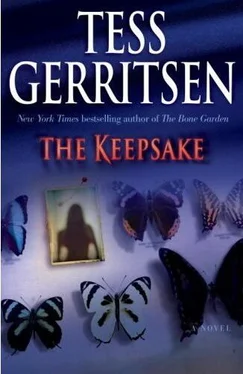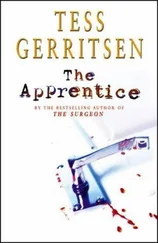“He’s still alive, Jane. And he’s right here in Boston.”
The door to the anteroom swung open, and a silver-haired gentleman stepped in, tying on a surgical gown.
“Dr. Vandenbrink?” said Maura. “I’m Dr. Isles. I’m glad you could make it.”
“I hope you haven’t started yet.”
“We were waiting for you.”
The man came forward to shake her hand. He was in his sixties, cadaverously thin, but his deeply tanned face and eager stride revealed not sickness but lean good health. As Maura made the introductions, the man gave scarcely a glance at Jane and Frost-his attention was riveted instead on the table where the victim lay, her twisted form mercifully concealed by a drape. Clearly it was the dead, not the living, that most interested him.
“Dr. Vandenbrink is from the Drents Museum in Assen,” said Maura. “He flew in last night from the Netherlands, just for this autopsy.”
“And this is her?” he said, his gaze still on the draped body.
“Let’s take a look at her, then.”
Maura handed him a pair of gloves, and they both snapped on latex. Maura reached for the drape, and Jane steeled herself against the view as the sheet was peeled back.
Naked on stainless steel, exposed by bright lights, the contorted body looked like a charred and twisted branch. But it was the face that would forever haunt Jane, the features glossy as black carbon, frozen in a mortal scream.
Far from horrified, Dr. Vandenbrink instead leaned closer with a look of fascination. “She’s beautiful,” he murmured. “Oh yes, I’m glad you called me. This was certainly worth the trip.”
“You call that beautiful?” said Jane.
“I refer to her state of preservation,” he said. “For the moment, it’s almost perfect. But I’m afraid the flesh may start to decay now that it’s exposed to air. This is the most impressive modern example I’ve encountered. It’s rare to find a recent human subject that’s undergone this process.”
“Then you know how she got this way?”
“Oh yes. She’s very much like the others.”
“Others?”
He looked at Jane, his eyes so deep-set that she had the disturbing impression a skull was gazing back at her. “Have you ever heard of the Yde Girl, Detective?”
“No. Who is she?”
“Yde is a place. A village in the northern Netherlands. In 1897, two men from Yde were cutting peat, something that was traditionally dried and burned as fuel. And in the bog, they found something that terrified them. It was a female with long blond hair who had clearly been strangled. A long band of fabric was still wrapped three times around her neck. At first, the people of Yde didn’t understand what they were dealing with. She was so small and shrunken, they thought she was an old woman. Or perhaps a demon. But over time, as scientists came to look at her, they were able to learn more about the corpse. And they discovered that she was not an old woman when she died, but a girl of only about sixteen. A girl who had suffered from a crooked spine. A girl who was murdered. She was stabbed beneath the collarbone, and a band was tightened around her neck until she strangled. Then she was placed facedown in the bog, where she lay for centuries. Until those two peat cutters found her and revealed her to the world.”
“Centuries?”
Vandenbrink nodded. “Carbon fourteen dating tells us she’s two thousand years old. When Jesus walked the earth, that poor girl may already have been lying in her grave.”
“Even after two centuries, they could tell how she died?” said Frost.
“She was that well preserved, from her hair to the cloth around her neck. Oh, there was damage done to her body, but it had been inflicted far more recently, when she was dredged up with the peat. Enough of her was left intact to form a portrait of who she was. And how she must have suffered. That’s the miracle of bogs, Detective. They give us a window back in time. Hundreds of these bodies have been found in Holland and Denmark, Ireland and England. Each one is a time traveler, an unfortunate ambassador of sorts, sent to us from people who left no written records. Except for the cruelties they carved into their victims.”
“But this woman”-Jane nodded at the body on the table-
“she’s obviously not two thousand years old.”
“Yet her state of preservation is every bit as exquisite. Look, you can even see the ridges on her soles and her finger pads. And see how her skin is dark, like leather? Yet her features clearly tell us she’s Caucasian.” He looked at Maura. “I completely concur with your opinion, Dr. Isles.”
Frost said, “So you’re telling us this body was preserved in the same way as that girl in the Netherlands?”
Vandenbrink nodded. “What you have here is a modern bog body.”
“That’s why I called Dr. Vandenbrink,” said Maura. “He’s been studying bog bodies for decades.”
“Unlike Egyptian mummification techniques,” said Vandenbrink, “there’s no written record of how to make a bog body. This is a completely natural and accidental process that we don’t entirely understand.”
“Then how would the killer know how to do it?” Jane asked.
“Within the bog body community, there’s been quite a bit of discussion about just this topic.”
Jane gave a surprised laugh. “You have a community?”
“Of course. We have our own meetings, our own cocktail parties. A great deal of what we discuss is purely speculative. But we do have some hard science to back up the theories. We know, for instance, that there are several characteristics about bogs that contribute to corpse preservation. They’re highly acidic, they’re oxygen-poor, and they contain layers of sphagnum moss. These factors help arrest decomposition and preserve soft tissues. They darken the skin to the color you see in this body here. If allowed to steep for centuries, eventually this corpse’s bones will dissolve, leaving only the preserved flesh, leathery and completely flexible.”
“Is it the moss that does it?” asked Frost.
“It’s a vital part of the process. There’s a chemical reaction between bacteria and the polysaccharides found in sphagnum moss. Sphagnum binds bacterial cells so they can’t degrade organic materials. If you bind the bacteria, you can arrest decomposition. The whole process happens in an acidic soup that contains dead moss and tannins and holocellulose. In other words, bog water.”
“And that’s it? Just stick the body in bog water, and you’re done?”
“It’s a little more exacting than that. There’ve been several experiments using piglet cadavers in Ireland and the UK. These were buried in various peat bogs, then exhumed months later for study. Since pigs are biochemically similar to us, we can assume the results would be the same for humans.”
“And they turned into bog pigs?”
“If the conditions were just right. First, the pigs had to be completely submerged or they would decompose. Second, they had to be placed into the bog immediately after death. If you let the corpse sit exposed for just a few hours before you submerged it, it would go on to decompose anyway.”
Frost and Jane looked at each other. “So our perp couldn’t waste any time once he killed her,” said Jane.
Vandenbrink nodded. “She had to be submerged soon after death. In the case of European bog bodies, the victims must have been walked into the bog while still alive. And only then, at the water’s edge, were they murdered.”
Jane turned and looked at the brutally shattered tibias on the X-ray light box. “This victim couldn’t have walked anywhere with two broken legs. She’d have to be carried in. If you were the killer, you wouldn’t want to do that in the dark. Not if you’re walking through a bog.”
Читать дальше












